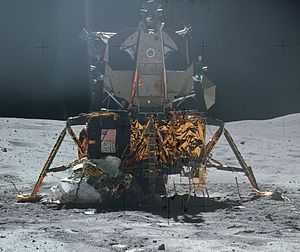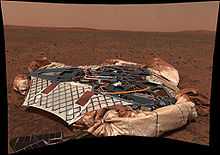Lander (spacecraft)


A lander is a spacecraft which descends toward and comes to rest on the surface of an astronomical body.[1] For bodies with atmospheres, the landing occurs after atmospheric entry (or less precisely for other planets, atmospheric reentry) and the lander is first a re-entry vehicle. In these cases landers may employ parachutes to slow down and to maintain a low terminal velocity. Sometimes small landing rockets are fired just before impact to reduce the impact velocity. Landing may be accomplished by controlled descent and setdown on landing gear, with the possible addition of a post-landing attachment mechanism for celestial bodies with low gravity.
The Mars Pathfinder mission used inflatable airbags to cushion the lander's impact rather than a more traditional landing gear. When a high velocity impact is planned, the spacecraft is called an impactor.[2]
Several terrestrial bodies have been subject of lander and/or impact exploration: among them the planets Mars and Venus and the Saturn moon Titan. Of the inner Solar System planets, Mercury is the only one that is yet to be visited by a lander.
Landers
Mars
Image map of Mars landings
The following imagemap of the planet Mars has embedded links to geographical features in addition to the noted Rover and Lander locations. Click on the features and you will be taken to the corresponding article pages. North is at the top; Elevations: red (higher), yellow (zero), blue (lower).

The Soviet Union's Mars 2 lander was the first Earth based mission to reach the surface of Mars in 1973, but communication was lost within a minute after touchdown, which occurred during one of the worst global dust storms since the beginning of telescopic observations of the Red Planet. Three other probes, Mars 3, Mars 5, and Mars 6, either crashed or failed to even enter the planet's atmosphere during the 1973 and 1975/76 windows. All four landers were based on the Luna 9 lander, and employed an aeroshell-like heat shield during atmospheric entry.
Viking 1 and 2 were launched respectively in August and September 1975, each comprising an orbiter vehicle and a lander. Viking 1 landed in July 1976 and Viking 2 in September 1976. The Viking program ended in May 1983, after both landers had died.
Mars Pathfinder was launched in December 1996 and released the first rover on Mars, named Sojourner, in July 1997. It failed in September 1997, probably due to electronics failure caused by the cold temperatures.

Mars Polar Lander ceased communication on 3 December 1999, prior to reaching the surface, and is presumed to have crashed.
The European Beagle 2 lander deployed successfully from the Mars Express spacecraft but the signal confirming a landing which should have come on 25 December 2003 was not received. Indeed no communication was ever established and Beagle 2 was declared lost on 6 February 2004.
Mars Exploration Rovers Spirit and Opportunity were launched in June and July 2003. They reached the Martian surface in January 2004 using landers featuring airbags and parachutes to soften impact. Spirit ceased functioning in 2010, more than five years past its design lifetime.[3] As of August 2014, Opportunity remains active, having exceeded its three-month design lifetime by over a decade.[4]
The U.S. Phoenix spacecraft successfully achieved soft landing on the surface of Mars on May 25, 2008, using a combination of parachutes and rocket descent engines.
Mars Science Laboratory (Curiosity) was successfully launched by NASA on November 26, 2011. It landed in the Aeolis Palus region of Gale Crater on Mars on August 6, 2012.
Lunar
A number of Moon probes, such as some members of the Soviet Luna program and the American Ranger program, were intended impactors not providing data after the crash.
The Soviet Luna 9 was the first spacecraft to achieve a lunar soft landing and to transmit photographic data to Earth. The American Surveyor program was designed to determine where Apollo could land safely; thus these robotic missions required soft landers to sample the lunar soil and determine the thickness of the dust layer, which was unknown before Surveyor.
The Apollo Lunar Modules and Lunakhod landers used a rocket descent engine for a soft landing of astronauts and lunar rovers on the Moon.
The Altair spacecraft, previously known as the "Lunar Surface Access Module" or "LSAM", was the planned lander for Project Constellation, prior to the cancellation of Project Constellation.
As of August 2012 NASA is developing vehicles that use a rocket descent engine permitting them land on the Moon and other locations. These vehicles include the Mighty Eagle lander and the Morpheus lander. The Project Morpheus lander may have sufficient thrust to propel a manned ascent stage.
The Chinese Chang'e 3 mission and its Jade Rabbit rover landed on 14 December 2013.
Titan

The Huygens probe, carried to Saturn's moon Titan by the Cassini probe, was specifically designed to survive landing on land and on liquid. It was thoroughly drop-tested to make sure it could withstand impact and continue functioning for at least three minutes. However, due to the low speed impact, it continued providing data for more than two hours after it landed.
Venus
The Soviet Venera program included a number of Venus landers, some of which were crushed during descent much as Galileo's Jupiter "lander" and others of which successfully touched down. The Soviet Vega program also placed two balloons in the Venusian atmosphere.
Mercury
ESA's BepiColombo mission to Mercury would have carried the Mercury Surface Element. The MSE would carry a 7 kg payload consisting of an imaging system (a descent camera and a surface camera), a heat flow and physical properties package, an alpha particle X-ray spectrometer, a magnetometer, a seismometer, a soil penetrating device (mole), and a micro-rover.
Comets and asteroids
The Rosetta probe, launched 2 March 2004, has put the robotic lander Philae on comet Churyumov–Gerasimenko on 12 November 2014. Due to the extremely low gravity of such bodies, the landing system includes a harpoon launcher intended to anchor a cable in the surface and pull it down.
A landing on a similarly small body, the asteroid 433 Eros, was performed by the probe NEAR Shoemaker despite the fact that NEAR was not originally designed to be capable of landing.
The Hayabusa probe made several attempts to land on 25143 Itokawa with mixed success, including a failed attempt to deploy a rover.
Impactors

Mars Deep Space 2
The Deep Space 2 impactor probe was to be the first spacecraft to penetrate below the surface of another planet. However the mission failed with the loss of its mother ship, Mars Polar Lander after communication was lost after entry into Mars atmosphere on 3 December 1999.
Deep Impact
Comet Tempel 1 was visited by NASA's Deep Impact probe on 4 July 2005. The impact crater formed was approximately 200 m wide and 30–50 m deep, and detected the presence of silicates, carbonates, smectite, amorphous carbon and polycyclic aromatic hydrocarbons.
See also
- List of artificial objects on the Moon
- List of artificial objects on Mars
- List of artificial objects on Venus
References
- ↑ Ball, Garry, Lorenz and Kerzhanovich (2006). "Planetary Landers and Entry Probes".
- ↑ Phil Davis; Kirk Munsell (23 January 2009). "Deep Impact Legacy Site: Technology – Impactor". Solar System Exploration. NASA / JPL. Retrieved 2009-04-22.
- ↑ "Meteorite Found on Mars Yields Clues About Planet's Past". NASA. 10 August 2009. Retrieved 2009-09-08.
- ↑ "Opportunity Status". NASA. Retrieved August 19, 2014.
